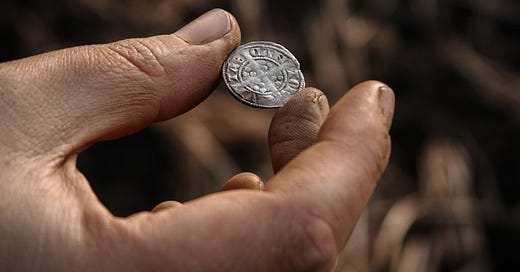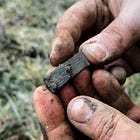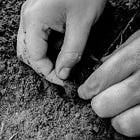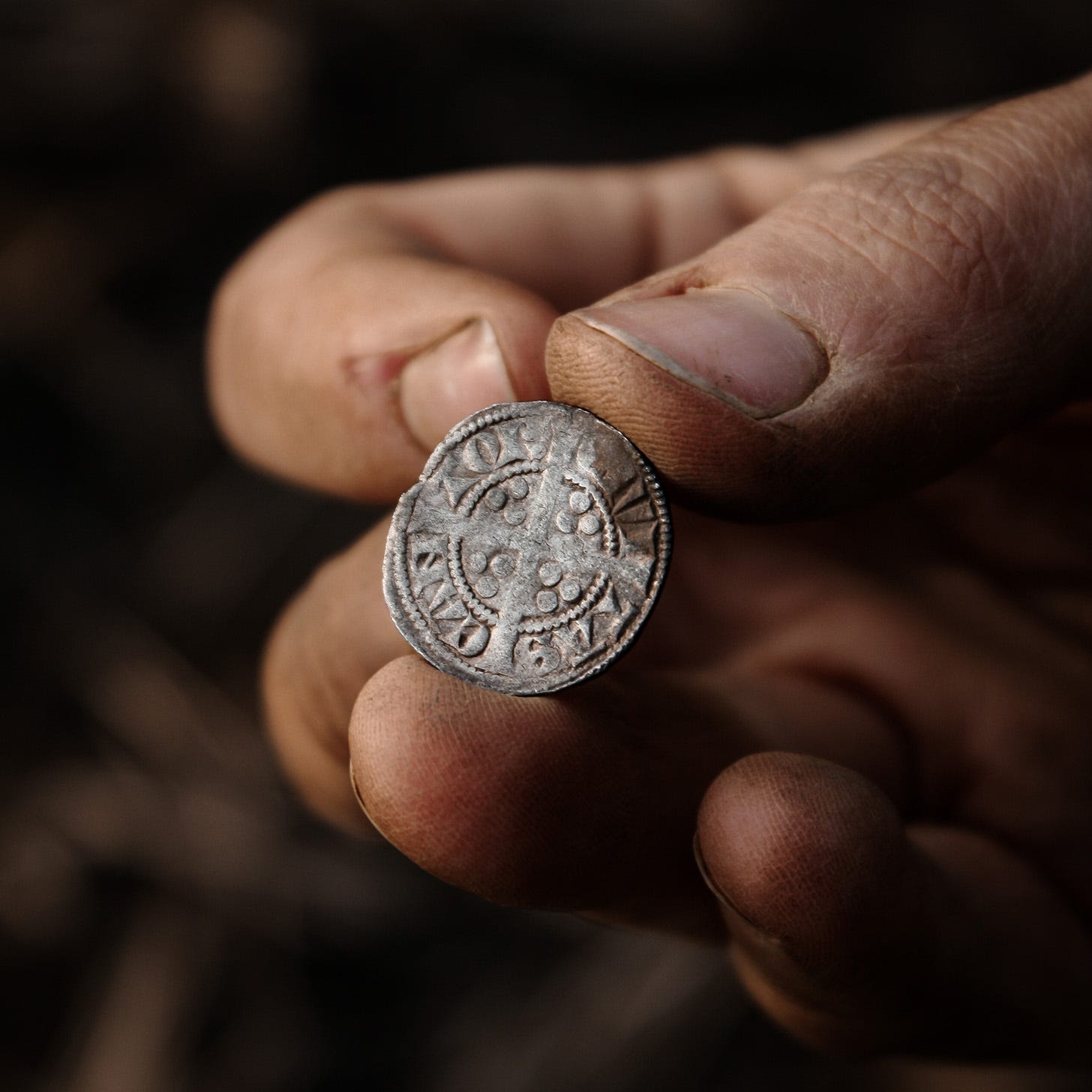Ebay, Depop, Amazon. We all have our spending vices; it could be the latest tech, the newest fashion drop, or even a trendy drink bottle (catch Ellie sporting her new camo Yeti bottle next dig). In this age, we don’t need to carry change around to drop a few bucks; we just need that plastic card in your wallet. But what about the Middle Ages? When the only form of spending was through the silver penny…
Medieval Spending Habits
Much like today, the people of the Middle Ages loved to shop. This was a relatively new experience for them after all, with rapidly developing trade and commerce throughout the Medieval world, creating the widespread birth of markets and international fairs - the shopping malls of the Middle Ages.
The Medieval marketplace was the hustling, bustling heart of the town. Virtually every community was gaining access to a regular market, opening up a whole new world of consumer goods, when previously, they were restricted solely to the trades and skills present within their local resources. We take for granted the ability to log into Amazon and check out any product we desire; in Medieval society, what you bought was heavily dependent upon the skills and produce of your peers. If you needed a plank of wood, then you better hope a carpenter was present in your nearest market.
So What Could You Buy in the Middle Ages?
Fish
A popular choice of Medieval England, with many varieties, such as fresh salmon and turbot, carrying a hefty price only afforded by the nobility.
Grains
Wheats, Barley, Oats and Ryes. Fresh from the field, ready to be sold to your average townsman.
Livestock
Chickens, Pigs, Sheep, Cows and Goats. An expensive purchase, just a single chicken, could cost more than a labourer’s daily wage.
Garden Produce
Fruits, Vegetables and Herbs. With the majority of a Medieval diet centred around Meat, Cheese and Cereals, these are somewhat of a commodity.
Spices
Very exotic purchases of pepper, nutmeg, cinnamon, cloves and sugar cost twice as much as the average worker’s daily wage.
Raw Materials for Craft
Sacks of wool, furs, iron, steel and tin. All mined/produced locally and sold onwards for manufacture. At a Medieval market in Lincolnshire, you could find wool in abundance!
Manufactured Produce
Pottery vessels, planks of wood, woolen cloth, dress fittings, nails, horseshoes, candlesticks. The hard work of your local craftspeople and makers.
A Penny for Your Thoughts
The Middle Ages in England covered a vast period between 1066 and 1485, a time of progression, development, and expansion, with links with mainland Europe strengthened and this new trade and commerce slowly developing a more monetary-based economy over barter and trade.
The silver penny is the most common denominator of English currency at this time. Because they are minted of quality silver, even a badly worn, unrecognisable silver penny still contained an acceptable level of silver content. Therefore, at no one time would your Middle Ages purse contain just one monarch’s coins; for example, in the reign of Edward III, it might be coins of the lengthy reign of his father Edward I that are the predominant currency. But with a currency almost exclusively made up of these silver pennies, it did come with its challenges, and for the everyday villager, there was a distinct lack of small change. How were you expected to buy a loaf of bread if it cost less than a penny? The simple answer was to cut your penny into halves and quarters to create smaller change. Alternatively, if you were a noble making a large purchase (there wasn’t any gold currency minted until 1344), you’d need quite a large sack. Making any transaction in the Middle Ages presented a bit of a problem! But what coins could you expect to see in your loose change?
The Norman Penny (1066 - 1158 AD)
The oldest coins found in the Middle Ages are those of the Norman Kings, minted across the country at over 70 mints. But clipping and forgeries were rife - even the moneyers were minting debased and underweight coins.
William the Conqueror
As a new invader William’s coins are vessels for promotions of his power and legitimacy, featuring motifs such as in the ‘bonnet’ and ‘two stars’ pennies which reference the appearance of Halley’s comet in 1066; a coincidental celestial event that utilised as a signal of William’s divine right to rule.
William II
Facing many challenges to his rule, both at home and abroad, William’s coins demonstrate his strength and power, with 3 out of the 5 different types of pennies he struck depicting himself holding a sword.
Henry I
Issuing 15 types of pennies over 35 years, Henry I was not only the longest-reigning English monarch since Aethelred II, but he also possessed the most diverse coinage of any Norman monarch.
Stephen I
With his reign tainted by ‘The Anarchy’, England’s first civil war, Stephen’s coinage was not the only coinage struck during this period with a series of unofficial, irregular, baronial types and even coins minted with deliberately garbled legends to not reveal any allegiances, filling the pockets of the public.
Henry II Tealby Penny (1158 - 1180 AD)
Henry inherited one hot mess of a coinage system upon his ascension to the throne in 1154. Although the coins that he introduced in his recoinage (as the solution for the currency problems) weren’t much better, turning out to be the worst quality coins in English history.
This, bearing distinctive crosslets, was the Tealby penny, a new standard for English currency that was meant to restore the public’s confidence following the troubles of the civil war experienced under Stephen I. In response to the irregular and unofficial minters of ‘The Anarchy, ’ Henry strengthened sovereign control over currency, reducing the number of regional mints into a smaller, more centralised field, with the London mint at the forefront. Yet the coins produced were incredibly poor, weakly struck, and found in all sorts of shapes that were far from circular…
To dig further into the fascinating history of the worst coins minted in English history, check out our newsletter here:
Short Cross Penny (1180 - 1247 AD)
The short cross penny was the remedy brought in to rectify Henry II’s failed attempt to fix England’s substandard currency with the Tealby pennies.
This saw the introduction of a brand new design, one that would remain virtually unchanged throughout the sixty-seven years of their issue. So unchanged in fact that despite being issued during the reigns of Henry II, Richard I, John, and Henry III, they only ever bore the name ‘Henry’ in the legend no matter who was reigning. This rather unusual numismatic decision was meant to give the public a sense of stability that had been previously lacking with English coinage and presented quite the puzzling enigma for the modern-day numismatist - with 67 years of almost identical coins and no clue which monarch they belonged to. It wasn't until the discovery of the Eccles Hoard in 1864 (which contained no fewer than 5715 English short cross pennies) that an important turning point was made in the chronological ordering, dating and identifying of short crosses.
Voided Long Cross Penny (1247 - 1279 AD)
The condition of the money circulating in England in the 1240s was probably as bad as it had ever been. A high proportion of the short cross pennies were badly worn, but more significantly, many were also clipped - an illegal practice where unscrupulous individuals would clip and melt slivers of metal from around the coins’ edge and profit by selling the silver.
So Henry III introduced England’s third recoinage in less than a century and yet another new design of penny: the voided long cross. By extending the short cross to the very edge of the flan, it was hoped this new design would thwart the clippers, as any coin circulating without any of its four cross-ends would be invalidated and illegal. What they didn’t take into account, however, was the accuracy of the moneyers themselves, with coins often struck off-centre. Whoops!
Long Cross Penny (1279 - 1489 AD)
By this point, it shouldn’t be of any surprise that by the time we get to Edward I in 1272, the circulating currency was, yet again, in an incredibly poor state. Hoarding, clipping and general wear and tear left only the worst quality coins passing hands - England needed another recoinage, but this time, this would be the one that sticks.
This was a major recoinage, seeing the entire English currency overhauled. New denominations were introduced: Halfpenny and farthing. There was no way only pennies would be able to fulfil the trade and commerce requirements of a rapidly expanding English nation, and die production was changed, introducing more complex punches which had features engraved in their entirety. Coin art was (once again) elevated, only this time it established a pattern for the design and production of English coins that was to last for more than two hundred years and through eleven reigns.
Which other coin histories would you like us to explore? We have quite a collection!
















Inventories that accompany wills in the archives sometimes are great resources for pricing household items. Some interesting details there in your article, Thankyou
SUCH a good read. Thank you---this is exactly the sort of content many souls are crying out for. Thank you so much!